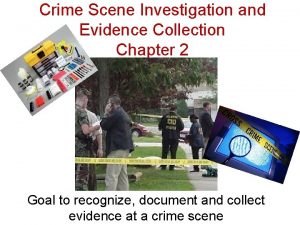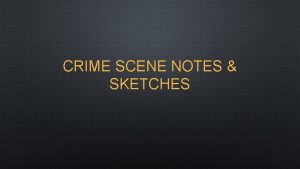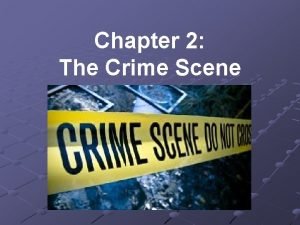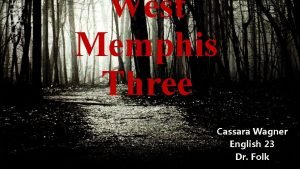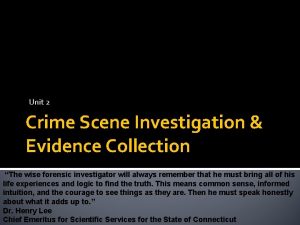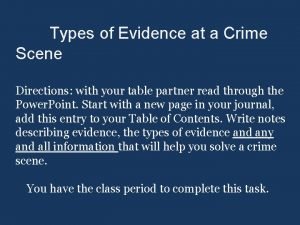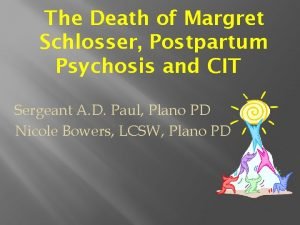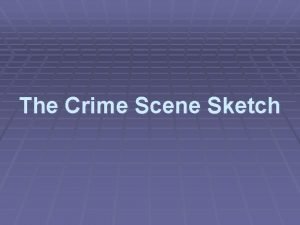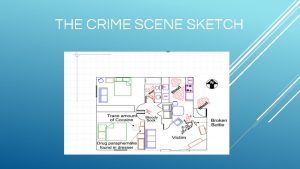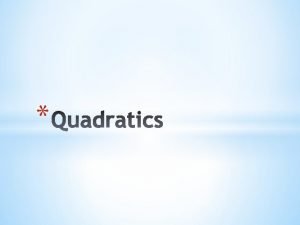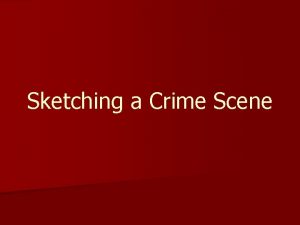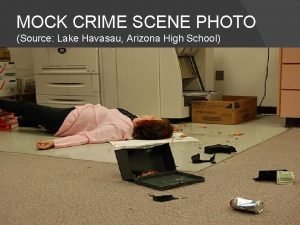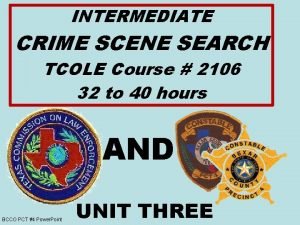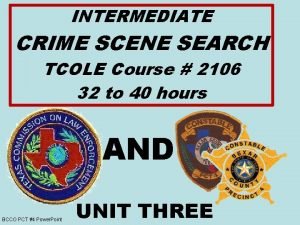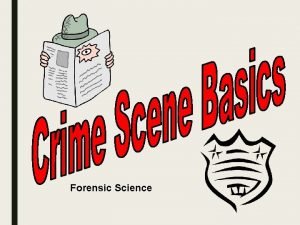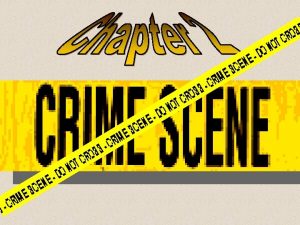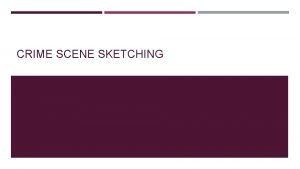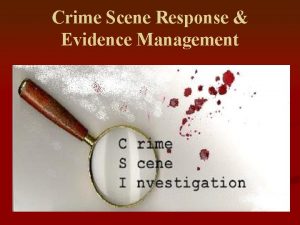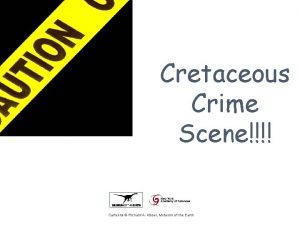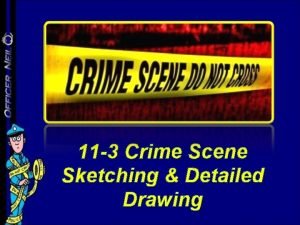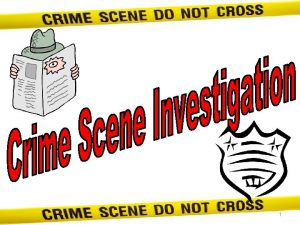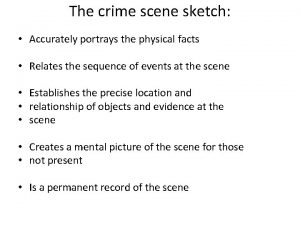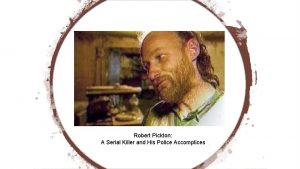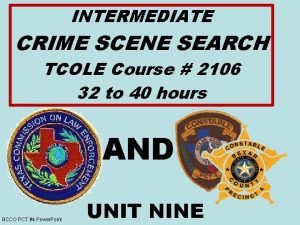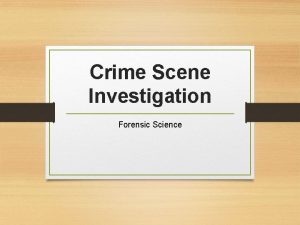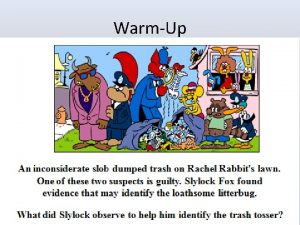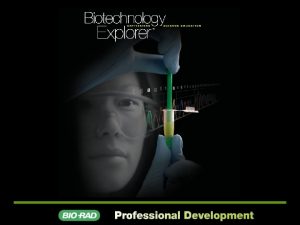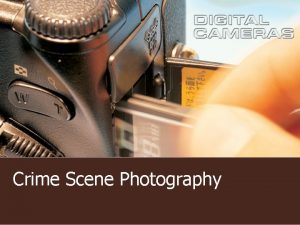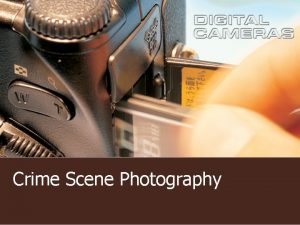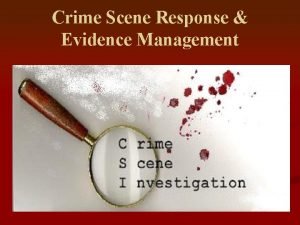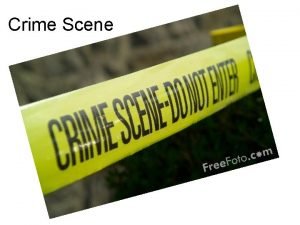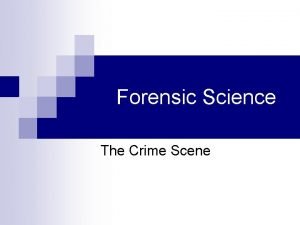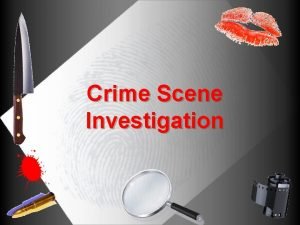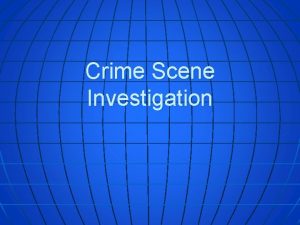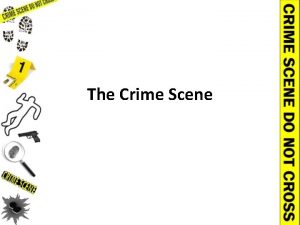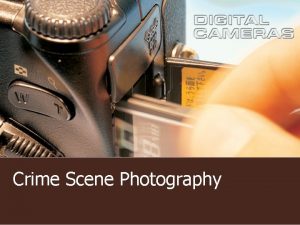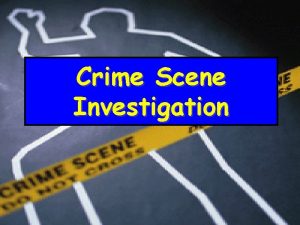Crime Scene Investigative Team Notes on provided notes




























- Slides: 28

Crime Scene Investigative Team Notes on provided notes page (page 47)

Who’s at the scene? First Responder (police officer) n Team leader n Photographer n Sketch preparer n Evidence Recorder/Custodian n Specialists n

First Responder n What are the responsibilities of the first responder?

First Responder n What are the responsibilities of the first responder? Determine the nature of the crime n Get medical assistance if needed n Isolate the crime scene n Detain suspects and witnesses n

Team Leader Assume control of the scene n Conduct initial walk-through n n Make preliminary survey, evaluate potential evidence, prepare a narrative description Determine search patterns n Control access to scene (designate another person to guard entrance; keep a log of who enters scene) n Releases scene when appropriate n

Photographer n Photograph: Entire area n Crowds, suspects, victims n Entire scene with overall, medium and closeup photographs n Major evidence n n Prepare photographic log

Sketch Preparer Diagram immediate area of scene n Locate major pieces of evidence to diagram on sketch n Label areas to be searched n Take measurements n Make sure sketch is labeled and includes all necessary information n

Evidence Recorder Describe evidence and its proper location on bag or label n Sign and date evidence label…. why? n n Chain of custody! Collect and package evidence n Keep evidence log n

Who’s the specialists? Anthropologist n Blood Spatter Analyst n Bomb Technician n Entomologist n Medical Examiner (Pathologist) n Odontologist n

Searching a Crime Scene Notes on Page 49

Determine Search Pattern Grid Linear Pattern End Begi n End Quadrant Spiral or Zone Pattern Begi n

Grid Pattern Best used in large, outdoor scenes Grid n Provides a double Pattern check of the area n End Begin

Linear Pattern n Best search for indoor areas when there is one searcher Linear Pattern End Begin

Quadrant or Zone Patter Best used when there are multiple people available to search n Area is divided into zones n Each searcher is assigned a zone n Another searcher can double check somebody else’s n Quadrant or Zone Pattern

Spiral Pattern Used best in outdoor scenes by one searcher n Start on outside edge, make smaller concentric circles as you search n Spiral Pattern

Why search patterns? Ensure no part of the crime scene goes unsearched n All evidence is located n

Documenting a Crime Scene Notes on provided notes page (page 51)

Note Taking Forces investigators to be more observant n Should detail every step you took while at the crime scene n Necessary information in notes: n Date, time, description of the location, weather, description of the crime, location of evidence relative to key points, names of people involved n Also include written description of physical evidence, location, time of discovery and packaging n

Guidelines for Note Taking n Take notes in pen in bound notebook n n Cannot erase pen Number pages consecutively before taking notes in notebook n Shows that pages have not been removed or destroyed Draw a single line through mistakes (do not completely mark through mistake) n Initial and date each page n Notes can be used as evidence in trial n

Why Sketches? Complete rough sketch at scene; make final copy after leaving n Sketches give perspective to photographs taken at crime scene n Record relationships of different points of interest in a crime scene n Important details: n n Date and time, scale, reference points, distance measurements, names of investigators, victims and suspects, and a legend

Sketch Terms n Definitions: n n n Measurements: length of each wall, piece of furniture, size of evidence, distance from fixed points to pieces of evidence Compass directions: shows the direction of north Scale of proportion: each object in the room should be relatively proportionate to the length of walls (ex. Couch should not take up more room along a wall in sketch as compared to reality) Title: Informs people of the location of the sketch, date and time, case #, person drawing the sketch Legend/Key: evidence represented by numbers, fixed points and large objects represented by letters (do not

Drawing Location of Objects Need to accurately draw where objects were located in crime scene n Use measurement techniques to determine where objects were n Several different methods: n n Triangulation: measurements taken from two fixed points to point on object to create an imaginary triangle

Nightstand Lamp Door to Bathroom TV Blood Nightstand Lamp Dresser Door to Hallway

Drawing Location of Objects n Several different methods: n Rectangular coordinates: Using a straight line between two points (can be a wall), measure once in the same direction as the line and once perpendicular to the line

Nightstand Lamp Door to Bathroom TV Blood Nightstand Lamp Dresser Door to Hallway

Drawing Location of Objects n Several different methods: n Straight line: measurements are taken from fixed points to either side of the object

Nightstand Lamp Door to Bathroom TV Blood Nightstand Lamp Dresser Door to Hallway

Drawing Location of Objects n Several different methods: n Transecting baselines: lay a measuring tape from 2 fixed positions; evidence is measured from the baseline at 90 degrees (usually used outside)
 While the csi team is searching the crime scene, _____.
While the csi team is searching the crime scene, _____. Crime scene notes
Crime scene notes Youtube.com
Youtube.com Wm3 autopsy photos
Wm3 autopsy photos Seven s of crime scene
Seven s of crime scene Types of crime scene
Types of crime scene Margaret schlosser autopsy
Margaret schlosser autopsy Final sketch
Final sketch Baseline crime scene sketch
Baseline crime scene sketch Cross projection method sketching
Cross projection method sketching Graphsketch
Graphsketch Sketching the crime scene
Sketching the crime scene Scene plan
Scene plan Intermediate crime scene search #2106
Intermediate crime scene search #2106 Intermediate crime scene search #2106
Intermediate crime scene search #2106 Crime scene factoring and quadratic functions answer key
Crime scene factoring and quadratic functions answer key Crime scene investigation vocabulary
Crime scene investigation vocabulary Forensic science begins at the crime scene
Forensic science begins at the crime scene Scene
Scene Crime scene photography management
Crime scene photography management Crime scene vocabulary
Crime scene vocabulary Cretaceous crime scene
Cretaceous crime scene Crime scene sketch
Crime scene sketch Vocabulary crime scene
Vocabulary crime scene A crime scene sketch should include
A crime scene sketch should include Strip search method crime scene
Strip search method crime scene Crime scene storyboard
Crime scene storyboard Robert pickton trailer
Robert pickton trailer Crime scene
Crime scene
